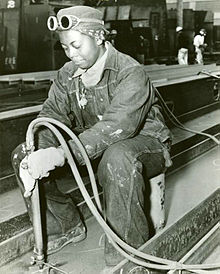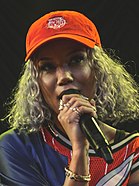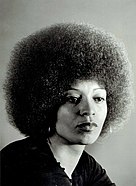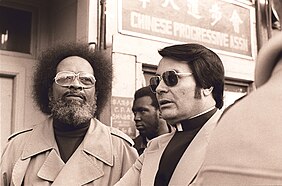African Americans in California
Afro-Puerto Ricans |
| Part of a series on |
| African Americans |
|---|





African American Californians, or Black Californians are residents of the state of
The Black community is prevalent in
California also has a growing
The earliest black residents were the first pioneers of Alta California and were Afro-Latino slaves (or mulatto) brought by the Spanish.[15][16] African Americans (and Louisiana Creole) migrated from Southern states like Oklahoma, Louisiana, Arkansas, and Texas to California during the Second Great Migration (1940s–1970s).[17][18]
The Black population in California has been declining since 2016, and moving out of the state along with Whites.
The black population has decreased in many neighborhoods and cities in California. Many areas such as Compton, Inglewood, and Watts that were once predominately black are now predominately Latino. Many Mexicans and Central Americans have displaced them in their historical areas.[25][26][27] In 2019, African Americans were more likely to become homeless in California.[28]
There is also a black foreign born population from Africa, Latin America and the Caribbean in California. 3% of black people in California are noncitizens, and 4% are naturalized immigrants. African Americans mainly live in Los Angeles, the
History
18th century
People of African descent first appeared in California from
19th century
Influential people of African ancestry were among the earliest California settlers and landowners.
After the discovery of
Some of the oldest African American churches in California are the Saint Andrews African Methodist Episcopal Church of Sacramento (founded in 1850, formerly known as Bethel African Methodist Episcopal Church), the Third Baptist Church in San Francisco (founded in 1852), Bethel African Methodist Episcopal Church (Bethel AME Church) in San Francisco (founded in 1852), African Methodist Episcopal Zion Church (AME Zion Church) in San Francisco (founded in 1852),[45] and the First African Methodist Episcopal Church of Los Angeles (founded in 1872).[46][47][48] In the 1870s, Rev. Peter William Cassey helped form two new Black Episcopalian churches in San Francisco; "Christ's Mission Church" (or Christ Mission Church), and he worked closely with the congregation from what later became St. Cyprian’s Church, however neither group had a building at that time.[49]
Many of the earliest African Americans in the state held the California State Convention of Colored Citizens, a series of colored convention events active from 1855 to 1902. At the conventions they had elected delegates from the various counties and would discuss topics like slavery, public education, and voting rights.[50][51]
Archy Lee had been formerly enslaved African-American and he was part of a series of notable 19th-century court cases that helped defined civil rights in the state by 1858.[52][53] Edward Duplex was the first Black mayor in California, elected to office in Wheatland in 1888.[54][55]
The first census recorded of African Americans in California appeared in 1850 with 962 people, and in 1860 with 4,086 people.[56] Then, in 1910 the number rose to 22,000.[57]
20th century
In the 1920s during the end of the Barbary Coast-era, Terrific Street was an entertainment district in San Francisco and it was home to numerous black and tan clubs (interracial clubs that often highlighted African American culture).[58]
African Americans migrated during the Second Great Migration from the Southern United States (places like Arkansas, Louisiana, Oklahoma and Texas) to the Northeast, Midwest and West to escape Jim Crow laws, between 1940 and 1970.[59] They also migrated to the state for better job opportunities, with many working in the defense industry and shipyards in California.[60][61] Of the Black Louisianans who migrated to California, a number were Louisiana Creoles.[62]
Before World War II, African Americans totaled to less than one percent of California's population.[57] The California population of African Americans grew slowly, alongside other minorities, with only 21,645 African American residents in 1910 compared to 2 million white residents.[63] Post-World War II, African Americans boosted their population enormously in California.[57]
Between the late-1940s until the early-1960s in San Francisco and Los Angeles, a new style of jazz was developed primarily by African Americans called West Coast jazz.[64]
In 1991, Rodney King, an African American, was the victim of police brutality when he was beaten by three Los Angeles Police Department (LAPD) officers during his arrest.[68][69][70] The Rodney King beating was caught on videotape, and after the police acquittal verdict the event was followed by the 1992 Los Angeles riots.[71] After the 1992 riots some 50 people were murdered, an estimated 2,000 people were injured and 8,000 people were arrested.[72]
Affirmative action is a set of laws, policies, guidelines, and administrative practices "intended to end and correct the effects of a specific form of discrimination".[73] In November 1996, affirmative action was abolished through Proposition 209 by California lawmakers.[74]
21st century
In the year 2000, California claimed 113,255 African immigrants in state, with the San Francisco Bay Area housing around 29,930 black immigrants. Most of the African immigrants came from Ethiopia. The next largest numbers were from Nigeria, Egypt, and South Africa. Approximately 45,000 Ethiopians and 6,000 Eritreans live in Los Angeles.[75] California is a destination for Egyptian and South African immigrants.[76]
In the 2010s, California was a
In 2020, anti-Black hate crimes in California has increased.[81][82][83][84] In 2020–2022, the COVID-19 deaths rose for African Americans in California, which had the lowest vaccination rates in the state.[85][86][87]
- Related museums
-
African American Firefighter Museum(formerly Fire Station No. 30), Los Angeles
-
California African American Museum, Los Angeles
-
Museum of the African Diaspora, San Francisco
Rural Black communities
Black people in California generally live in cities or metropolitan areas, although there are some rural Black communities, albeit unusual.
Central Valley areas like
Rural Southern Californian towns such as
Many Los Angeles Black individuals and families moved to areas with cheaper estate, such as
Marin City is over 27% black.
Media
The first African American newspaper in California is thought to be the Mirror of the Times, published in the mid-1850s.[88] Other early African American newspapers in Northern California included Pacific Appeal and The Elevator;[89] and in Southern California included the California Eagle, California Voice, and Los Angeles Sentinel.[57]
African American residents of California were first mentioned in 1919 by Black Californian historian Delilah Beasley, and later on Rudolph Lapp, others.[57] More information appeared in journals such as The Journal of Negro History and The Journal of African American History. (3)[90]
The largest film festival focused on black filmmaking is the Pan African Film Festival, founded in 1992.[91] Other notable film festivals dedicated to enhancing the careers of Black filmmaking professionals include The San Diego Black Film Festival and the Hollywood Black Film Festival.[92][93][94]
Education
This section needs expansion. You can help by adding to it. (July 2022) |
The Phoenixonian Institute of San Jose was the first high school for African American students in the state, it opened in 1861 as a private boarding school and closed in the mid-1870s when the state public schools were no longer segregated.[97] The funding and support for the Phoenixonian Institute initially came from the California State Convention of Colored Citizens and the African American community on the West Coast.[97]
In 1874, the
The first university Black studies department in the United States was created at San Francisco State University, following the Third World Liberation Front strikes of 1968.[99]
In 1994, California's African American students made up about seven percent of higher education, compared to nine percent in the country.[100]
Health
Black Californians have the highest death rates from breast, cervical, colorectal, lung, and prostate cancer.[101] In 2022, Blacks in California have died at a higher rate than other ethnic groups in from COVID-19 and had the lowest COVID-19 vaccination rates.[102] Blacks in California are more prone to obesity.[103] Homicide rates are higher for African Americans in California.[104]
Reparations
California was the first state to consider reparations for Black residents, and the California Reparations Task Force was formed in order to present the state legislature its recommendations.[105] Economists tell the state that Black Californians could be owed $800 billion in reparations. The $800bn is more than 2.5 times California's annual budget of $300 billion The statewide estimate includes $246 billion in compensation for eligible Black Californians whose neighborhoods were aggressively policed and prosecuted in the "war on drugs" from 1970 to 2020. That would be nearly $125,000 for each person who qualifies. Economists also included $569 billion in reparations for the discriminatory practice of redlining in housing loans. The compensation would be about $223,000 per eligible resident who lived in California from 1933 to 1977.[106]
According to a 2023 poll from the
Politics
82% of African Americans in California voted for Joe Biden in a exit poll in 2020.[108][109] 82% of African American voters are registered as Democrats.[110] 88% of African Americans in California voted for Hillary Clinton in 2016.[111][112]
Kamala Harris is the first African American female Vice President, and she was born and raised in California.[113]
Discrimination
In 2021, the total number of hate crime events reported is the sixth-highest-ever-recorded, and the highest since the aftermath of September 11, 2001.[114] According to a study by the California Department of Justice (DOJ), anti-Black hate crimes from 2021 to 2022 increased in the state by 27%; with all-over hate crimes also increasing by 20%.[114][115]
Blacks have higher arrest rates than white people in California’s 58 counties.[116]
California became the first state to ban discrimination based on natural African-American hair and hairstyles. The bill was signed into law by Gavin Newsom.[117]
African Americans are often victims of racial profiling in California.[118]
Demographics
Racial/ethnic makeup of California, treating Hispanics as a separate category (2017)[119]
| Ancestry by origin, 2018[14] | Number | % |
|---|---|---|
| 1,462 | ||
| 33,538 | ||
| 4,854 | ||
Kenyans
|
3,228 | |
| 2,415 | ||
| 36,415 | ||
Sierra Leoneans
|
1,278 | |
Somalis
|
5,022 | |
| 3,376 | ||
| 3,538 | ||
Ugandans
|
1,710 | |
| 408 | ||
| African | 110,116 | |
| Other African | 10,287 |
Notable Black Californians
- Jhené Aiko[120]
- Anthony Anderson
- Tyra Banks
- Blueface
- Barry Bonds
- Reggie Bush
- Nick Cannon
- Doja Cat
- Ice Cube
- Angela Davis
- George Washington Dennis
- Snoop Dogg
- Dr. Dre
- James Harden
- Kamala Harris
- H.E.R.[121]
- Paul George
- Mifflin Wistar Gibbs
- Tyrese Gibson
- Danny Glover
- Etta James
- Dwayne Johnson
- Rashida Jones
- Zoë Kravitz
- Kendrick Lamar
- Peter Lester
- Lauren London
- Miguel[122]
- Reggie Miller
- Shane Mosley
- Frank Ocean
- Issa Rae
- RuPaul
- Saweetie[123]
- Kofi Siriboe
- Carolynne Snowden
- Hailee Steinfeld
- Lakeith Stanfield
- Tinashe
- Karrueche Tran
- Bertha L. Turner
- Tyga
- Tyler, The Creator
- Maxine Waters
- Russell Westbrook
- Tiger Woods
- YG
- Nick Young
- Zendaya
- Notable Black Californian entertainers
-
-
Snoop Dogg (2019) from Long Beach
-
Tinashe is of Zimbabwean, Danish, Norwegian and Irish descent from Los Angeles
-
Jhené Aiko is of Spanish, Dominican, Japanese, Native American, African, and German-Jewish descent from Los Angeles
- Notable Black Californian politicians and political leaders
-
Angela Davis (1974)
-
Rev. Cecil Williams with Rev. Jim Jones (1977) at a protest, in front of the International Hotel in San Francisco
-
Tom Bradley(1984), former Mayor of Los Angeles
-
Willie Brown (1999), former Mayor of San Francisco
-
Kevin Johnson (2011), former Mayor of Sacramento and basketball player
-
Kamala Harris (2021), 49th Vice President of the United States
See also
- African Americans in San Francisco
- History of African Americans in Los Angeles
- California locations by race
- Demographics of California
- Afro-Mexicans
- Spanish California
- Hispanics and Latinos in California
- Blaxican
- Black Southerners
- African Americans in Texas
- African Americans in Georgia
- African Americans in Oklahoma
- African Americans in Louisiana
- Indigenous peoples of California
- White Americans in California
- Little Ethiopia
- Asian Americans in California
- History of California
- Mexicans in California
- African Americans in Oregon
- African Americans in the East San Francisco Bay Area
References
- ^ "QuickFacts California; Oakland city, California; San Francisco city, California". U.S. Census Bureau.
- ^ "The California Black Census & Redistricting Hub | California Calls". June 28, 2019.
- ^ African American Vernacular English in California - John Rickford
- ^ "Religious Landscape Study".
- ^ "BLACK OR AFRICAN AMERICAN ALONE OR IN COMBINATION WITH ONE OR MORE OTHER RACES". U.S. Census Bureau.
- ^ "U.S. Census Bureau, 2011-2015 American Community Survey 5-Year Estimates." American FactFinder. U.S. Census Bureau.
- ^ Greenwood, Shannon (March 25, 2021). "The Growing Diversity of Black America". Pew Research Center’s Social & Demographic Trends Project. Retrieved January 16, 2023.
- ^ A Portrait of Race and Ethnicity in California (Report). Public Policy Institute of California. Retrieved November 19, 2023.
- ^ California Black Population By County, 2018
- ^ "Resident Population Data - 2010 Census". 2010.census.gov. Archived from the original on December 25, 2010. Retrieved May 22, 2022.
- S2CID 38217029.
- ^ "'Blaxicans of L.A.' Instagram project comes to life as an exhibit in Highland Park". Los Angeles Times. February 12, 2016.
- ISBN 978-0-8147-7535-6.
- ^ a b c "Explore Census Data". 2018.
- ^ "Afro-Latinos". NPS.
- ISBN 978-0-292-77848-1– via Google Books.
- ^ "The African-American Migration Experience (AAME)". Schomburg Center for Research in Black Culture, The New York Public Library.
- ISBN 9781628467758.
- ^ "Racial/Ethnic Differences in Who's Leaving California". Public Policy Institute of California. Retrieved January 16, 2023.
- ^ "The California Black Census & Redistricting Hub | California Calls". June 28, 2019. Retrieved January 16, 2023.
- ^ "Black population in L.A. County declines as more return to South". Our Weekly LA. February 7, 2014. Retrieved January 16, 2023.
- ISSN 0362-4331. Retrieved January 16, 2023.
- ^ "Poverty in California". Public Policy Institute of California. Retrieved January 16, 2023.
- ^ Hepler, Lauren (July 15, 2020). "The hidden toll of California's Black exodus". CalMatters. Retrieved January 16, 2023.
- ISBN 9781610696661.
- ISBN 9780807778555.
- ISBN 9780226313702.
- ^ Cimini, Kate (October 5, 2019). "Black people disproportionately homeless in California". CalMatters. Retrieved January 16, 2023.
- ^ "California's African American Community".
- ^ "What's the most California county in California?". San Francisco Chronicle.
- ^ "Racial Segregation in the San Francisco Bay Area, Part 2".
- S2CID 145420060.
- ISBN 978-1-59714-145-1.
- ^ Encyclopedia of African American History, 1619-1895: From the Colonial Period to the Age of Frederick Douglass Three-volume Set. 2006.
- ^ Honig, Sasha. "The Presidios of Alta California". California Missions Foundation. Retrieved January 16, 2023.
- ^ Mills, Michelle (February 4, 2016). "Exhibit explores the African ancestry of the founders of Los Angeles". San Gabriel Valley Tribune.
- ^ "The Life and Times of Pío Pico, Last Governor of Mexican California". KCET PBS. October 10, 2017. Retrieved January 16, 2023.
- SFGATE. Retrieved February 16, 2021.
- ^ Schneider, Benjamin (December 8, 2021). "The incredible story of William Leidesdorff, San Francisco's Black founding father". San Francisco Examiner. Retrieved January 16, 2023.
- ISBN 978-0-517-80096-6.
- ^ "African Americans in the California Gold Rush (1848-1860) •". BlackPast. February 9, 2022.
- ^ "African Americans in the Gold Rush". American Experience, PBS. Retrieved January 16, 2023.
- ISBN 0-7872-6287-0.
- ISBN 9780783814261.
- JSTOR 25157430.
- ^ "St. Andrews AME Church (Sacramento), is Founded". African American Registry (AAREG). Retrieved January 16, 2023.
- ISBN 978-0-7385-8094-4.
- SFGATE. November 16, 2017. Retrieved January 16, 2023.
- ISBN 978-1-57859-424-5.
- S2CID 246985506.
- ISBN 978-0-300-06545-9.
- ISBN 978-0-8061-5685-9.
- ^ Wee, Eliza (June 28, 2018). "Archy Lee - Gold Chains: The Hidden History of Slavery in California". ACLU of Northern CA. Retrieved January 16, 2023.
- ^ "Edward Park Duplex (1831–1900)". BlackPast. November 26, 2008. Retrieved January 29, 2023.
- ISBN 978-0-19-530173-1. Retrieved July 30, 2022.
- ^ Bradford, Eric. "Free African American Population in the U.S. : 1790-1860." NCpedia Home Page | NCpedia. Ncpedia, 2008.
- ^ JSTOR 25177592.
- ISBN 978-1-4396-4928-2.
- ISSN 0360-0572.
- ^ "The Second Great Migration" (PDF).
- . Retrieved March 19, 2020.
- ISBN 9780739118962.
- ^ S2CID 149013832.
- JSTOR 29776316.
- SFGATE. Retrieved January 16, 2023.
- SFGATE. Retrieved January 16, 2023.
- SFGATE. Retrieved January 16, 2023.
- ISSN 0362-4331. Retrieved January 16, 2023.
- ^ "March 3, 1991: Rodney King beating caught on video". CBS News. March 3, 2016. Retrieved January 16, 2023.
- ISSN 0362-4331. Retrieved January 16, 2023.
- ^ Mydans, Seth (April 30, 1992). "THE POLICE VERDICT; Los Angeles Policemen Acquitted in Taped Beating". The New York Times. Retrieved January 16, 2023.
- ^ Lewis, Femi (December 16, 2020). "39 Events that Occurred in the 1990s". ThoughtCo. Retrieved January 16, 2023.
- .
- ISSN 0362-4331. Retrieved January 16, 2023.
- ISBN 9780814775356.
- ISBN 9780739111512.
- ^ "Politics | News from The Advocate". The Advocate. Retrieved November 5, 2020.
- ^ Payton, Allen (February 5, 2019). "Antioch Council hires first African American as City Attorney". The Antioch Herald. Retrieved March 19, 2020.
- ^ "These Are The 10 California Cities With The Largest Black Population For 2019". RoadSnacks. December 9, 2018. Retrieved May 13, 2019.
- ^ Tramble, Thomas and Wilma (2007). The Pullman Porters and West Oakland. Charleston, SC: Arcadia Pub.
- ^ "Anti-Black, gay, Asian bias fuel California hate crime surge". Omaha World-Herald. AP. Retrieved July 3, 2022.
- ^ "Anti-Black and Asian bias fuel California hate crime surge". Durango Herald. AP. Retrieved July 3, 2022.
- ^ "California hate crime up 31% in 2020, led by anti-Black bias". AP NEWS. June 30, 2021. Retrieved July 3, 2022.
- OCLC 1330888409.
- ^ Hwang, Kristen (February 25, 2022). "COVID-19 has turned deadlier for Black Californians, who have the state's lowest vaccination rate". CalMatters. Retrieved July 3, 2022.
- ^ "African-American COVID-19 deaths 'disproportionately' high in California". The Mercury News. April 16, 2020. Retrieved July 3, 2022.
- ^ Alexander, Kurtis (April 17, 2020). "Coronavirus appears twice as deadly for blacks as whites in California". San Francisco Chronicle. Retrieved July 3, 2022.
- JSTOR 25158067.
- ^ "'Since Before the Beginning': The Black Pioneers of the South Bay". KQED. February 18, 2021. Retrieved August 9, 2023.
- S2CID 149288451.
- The Los Angeles Times.
- San Diego Union-Tribune.
- ^ Beth Accomando (April 27, 2017). "San Diego Black Film Festival Celebrates 15th Year". KPBS.
- ^ "Tanya Kersey, founder of the Hollywood Black Film Festival, dies at 61". Los Angeles Times. July 21, 2022. Retrieved January 16, 2023.
- ISBN 978-0-7627-3900-4– via Internet Archive.
- ^ "Elizabeth Thorn Scott Flood, Educator born". African American Registry (AAREG). Retrieved January 29, 2023.
- ^ State of California, Department of Parks and Recreation, Office of Historic Preservation. 1988. p. 78.
- S2CID 156545977.
- ^ Rooks, Nowlie (February 10, 2006). "The Beginnings of Black Studies". The Chronicle of Higher Education. Retrieved March 2, 2021.
- JSTOR 2963084.
- ^ Health Care Almanac
- ^ Hwang, Kristen (February 25, 2022). "COVID-19 has turned deadlier for Black Californians, who have the state's lowest vaccination rate". Calmatters.
- ^ "In California… Who's Obese, Who's Not, And Why".
- ^ Kim, Mina (January 26, 2012). "Homicide Rate Among Calif. African-Americans Significantly Higher Than National Average". KQED. Retrieved December 27, 2023.
- ^ Fry, Wendy; Yee, Erica; Jetha, Rya (June 29, 2023). "California is the first state to tackle reparations for Black residents. What that really means". CalMatters. Retrieved November 15, 2023.
- ^ "Black Californians may be owed $800bn in reparations, economists tell state". The Guardian. March 30, 2023.
- ^ Florido, Adrian (September 11, 2023). "Most California voters oppose cash reparations for slavery, poll finds". NPR.
- OCLC 1330888409.)
{{cite news}}: CS1 maint: multiple names: authors list (link - ^ "California 2020 President exit polls". CNN.
- ^ "Just the Facts: Race and Voting in California". September 2016.
- ^ "California Results 2016". NBC News. November 28, 2016.
- ISBN 978-0-19-007736-5.
- ^ United States Congress. "African Americans in California (id: H001075)". Biographical Directory of the United States Congress.
- ^ a b Harvey, Antonio Ray (July 14, 2022). "Incidents of Hate Crimes Against Blacks Highest in California". Los Angeles Sentinel.
- ^ Flores, Hilda (June 28, 2023). "Hate crime reports in CA increased 20% from 2021 to 2022, report shows. Here's a closer look". KCRA. Retrieved July 21, 2023.
Hate crime reports in California increased about 20%; anti-Black hate crimes remain the most prevalent, with an increase of 27.1%
- ^ "Racial Disparities in California Arrests".
- ^ Stack, Liam (June 28, 2019). "California Is First State to Ban Discrimination Based on Natural Hair". The New York Times.
- ^ "Californians Fear Being a Victim of Crime, and Some Have Been Victims of Racial Profiling".
- ^ "B03002 HISPANIC OR LATINO ORIGIN BY RACE - California - 2017 American Community Survey 1-Year Estimates". United States Census Bureau. July 1, 2017. Archived from the original on February 13, 2020. Retrieved October 11, 2018.
- ^ "See All Our Favorite Celebrity 'Blasians' In Honor Of Asian Pacific American Heritage Month". BET.
- ^ Fil-Am singer H.E.R. talks of her Pinoy roots and writing the song featured in movie ‘Judas and the Black Messiah’
- ^ "The Evolution of Miguel". BET.
- ^ Blasians to Celebrate During Black History Month (and Every Other Month)
- ^ Doja Cat denies 'stripping for white supremacists' and using racist insults
External links
- African American History in Mexican California
- Black-Latino tensions on rise in California
- Hispanics: California's Next Majority, The New York Times
- "Afro-Latinos". Juan Bautista de Anza National Historic Trail (U.S. National Park Service). November 10, 2015. Retrieved December 9, 2023.
- Waite, Kevin (June 8, 2023). "The little-known story of how slavery infiltrated California and the American west". The Conversation. Retrieved December 9, 2023.
- California Once Tried to Ban Black People
- The hidden toll of California’s Black exodus
- Wheeler, B.G. (1993). Black California: The History of African-Americans in the Golden State. Hippocrene Books. ISBN 978-0-7818-0074-7.
- Black and Brown in Los Angeles: Beyond Conflict and Coalition
- LATINO GANG MEMBERS IN SOUTHERN CALIFORNIA ARE TERRORIZING AND KILLING BLACKS
- "California Cultures: African Americans". Calisphere. Retrieved December 9, 2023.
- Racial/Ethnic Differences in Who’s Leaving California
- Gordon Wheeler, B. (1993). Black California: The History of African-Americans in the Golden State. Hippocrene Books. ISBN 9780781800747.
- McGriff-Payne, Sharon (2012). African Americans in Vallejo. Arcadia. ISBN 9780738595818.
- California Cultures: African Americans
Further reading
- Seeking El Dorado: African Americans in California. University of Washington Press. September 27, 2023. ISBN 9780295980829.









![Doja Cat was born in Los Angeles and is South African and Jewish descent. She identifies as a black woman.[124]](http://upload.wikimedia.org/wikipedia/commons/thumb/6/67/Doja_Cat_2020_Vogue_Taiwan_01.png/139px-Doja_Cat_2020_Vogue_Taiwan_01.png)





